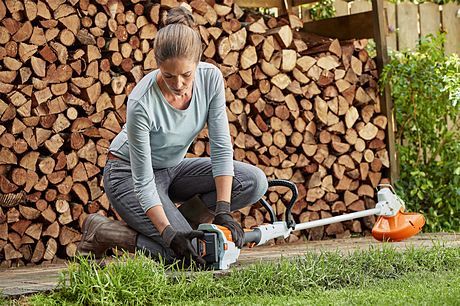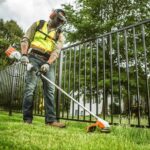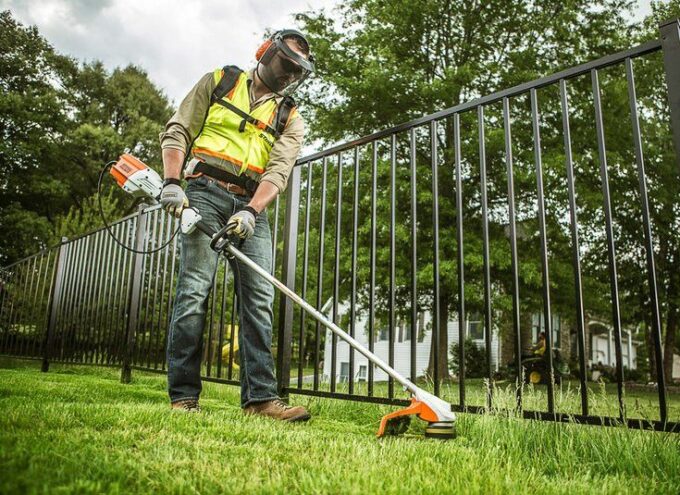Are You Ready for Trimming Grass and Cutting Back Weeds This Spring?
When the weather warms in the spring, weeds are some of the first things to start growing. Grass isn’t too far behind. With all the grass and weeds that grow up in the spring and summer, trimmers—also called weed eaters or weed whackers—are an essential yard care tool.
If you want your lawn to look great in the spots where a mower just can’t reach, a trimmer is an essential tool. Pond banks, rocky or steep hills, along fences, at the edge of gardens, and around children’s playsets are just a few of the spots where you’ll find a trimmer useful.
Whether you’re a homeowner looking to get a trimmer for around the yard or a lawn professional upgrading your equipment fleet, a reliable trimmer is a must-have. You’ll be using these tools a lot, so you want one that can stand up to regular use and keep trimming reliably.
How to Know When You Need a Trimmer
Depending on your yard, it might be possible to get along without a trimmer for a while. That’s what my parents did for many years. They used a riding mower for most of the yard and then a small walk-behind for trimming tasks. My dad bought a new trimmer last year, though, because it’s so much more convenient to use a dedicated tool for trimming. Now, he can keep the edges of flower beds, the garden fence, and the pond bank clear of weeds and grass much more easily than before.
Many homeowners and professionals already have trimmers but might be wondering if it’s time to replace the trimmer. Trimmers can last for many years (depending on how well you keep up with maintenance and how much you use them), but they do wear out eventually. Many professionals choose to replace their trimmers every year or so.
For homeowners, knowing you need a new trimmer typically happens when the old one stops working or doesn’t work as well as it used to. It might need lots of extra maintenance now or maybe it’s just not running as it should. Or perhaps it’s an old gasoline model that’s not environmentally friendly or fuel-efficient. Whatever the reason, if it’s time to replace your trimmer there are a few things to keep in mind.
What to Look For in a New Hand Held Trimmer
 Since trimmers are such an important lawn care tool, there’s a wide variety of options to choose from. This means you’ll be able to find something that fits your exact needs. It also means you’ll want to start narrowing down your options so you know what you want to look for. Answering these questions can help:
Since trimmers are such an important lawn care tool, there’s a wide variety of options to choose from. This means you’ll be able to find something that fits your exact needs. It also means you’ll want to start narrowing down your options so you know what you want to look for. Answering these questions can help:
Gas or electric?
Trimmers are either powered by a gasoline engine or an electric motor. You can get electric trimmers powered by an extension cord, but most are battery-powered. As a rule, gasoline trimmers are more powerful and may be less expensive up-front. It can also be easier to fill up a gas tank if you’re working for hours each day than charge batteries. However, battery-power trimmers are powerful enough for most trimming tasks. They’re also energy-efficient, quiet, and easy to maintain.
Multi-tool or dedicated trimmer?
Another choice you’ll have is between getting a tool that’s just a trimmer or getting a multi-tool with a trimmer as one of the attachments. This choice has to do with how you plan to use the tool. If you just want a trimmer, there’s no point in spending the extra money for a multi-tool. But if you also want a hedge trimmer, blower, edger, or other attachments, then a multi-tool can save you money. They’re also easier to store than a lot of individual tools.
Straight or curved shaft?
Most trimmers are hand-held tools with a straight or curved shaft. Try going to a store and handling each type to see which is more comfortable. Usually, curved shafts are easier to work with and they’re more comfortable for shorter people to use. Straight shafts work well for taller people and they’re good for reaching underneath things like a bench or deck.
What type of cutting head?
When choosing which trimmer you want, you’ll have some options with cutting heads. For string-line trimmers, some use a single cutting line (which is easier to refill) and others use two (which makes them cut faster). Cutting heads also vary in how they feed out the cutting line and how you replace it when it runs out. Bump heads feed out more line if you tap the cutting head on the ground. Automatic-feed heads release new line as needed while you’re cutting. Fixed-line heads use pre-cut pieces of line that are easy to replace but need to be changed out more frequently.
There’s also the option to get a brushcutter, which uses metal cutting blades instead of string-line. You’ll need one of these if you plan to cut woody weeds, bushes, small saplings, and dense undergrowth. Many trimmers offer the option to change out cutting heads so you can use either string-line or a brushcutting blade.
Trimming Tips to Use This Spring
Keep safety in mind whenever using power equipment like a trimmer. For trimmers, wear close-toed shoes and long pants to protect your feet and legs from the cutting head and from any debris that may get thrown up as you’re working. You should also wear eye protection. Hearing protection is also useful when working with gasoline engines. Also, keep an eye on what’s around you to avoid running into things like rocks, water hoses, or power cords in the yard.
Basic trimming is the skill you’ll most often use the trimmer for. Hold the cutting head at a slight angle to the ground and swing it back and forth. If you need to cut large areas with the trimmer, you can use a “scythe” motion with big, sweeping passes over the lawn. You can also use a trimmer for edging by holding the cutting head at a 90-degree angle, though you need to be careful with this since the angle makes it more likely you’ll fling small rocks or other yard debris up.
If you’re using a string-line trimmer instead of a brushcutter, make sure you keep the replacement line on hand. You can pick that up at Richardson Saw & Lawnmower. We carry replacement line and parts for all the trimmers we sell. If you’ve got any questions about your options with trimmers or you’re looking to buy a new one this spring, stop by and visit us. We’ll help you find a trimmer that’s just the right fit for your needs.




